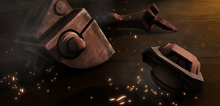| | |
The body of the deceased Padmé Amidala during her funeral on Naboo.
- "Death is a natural part of life. Rejoice for those around you who transform into the Force."
- ―Yoda
Death was the cessation of life functions in biological organisms, permanently rendering it unresponsive to any external factors. Once a life ended, its spirit would ascended to a different plane of existence and become one with the cosmic Force; however, some Jedi were able to maintain their conscious individuality beyond death by learning the secrets of the Living Force.[1][2]
Certain individuals who were not followers of the Jedi teachings often referred to the different plane where the dead reside as the "other side."[3] Many individuals also sought a way to forestall death or even avoid it entirely. Darth Plagueis was a Dark Lord of the Sith whose knowledge of the midi-chlorians was said to be such that he had the ability to keep those he cared about from dying. Anakin Skywalker, desperately seeking a way to prevent what he had seen come to pass in his vision of the death of Padmé Amidala, was entranced when Darth Sidious told him a tale of this.[4]

Death of a droid.
The Nightsisters of Dathomir kept their dead close by, suspended in pods near their village, so that no sister ever truly left the clan. They believed that the dead could share in the emotions of the living, and with a magical chant could temporarily be reanimated in the form of undead warriors. When the body of the last Nightsister, Asajj Ventress was laid to rest in the pools of the village, green mist arose as the voices of her sisters welcomed her home.[5] After death the spirits of the Nightsisters were tethered to the altar in the Nightsister lair, and in 2 BBY they were awakened by Ezra Bridger and Maul. Two Nightsister spirits possessed Ezra's friends Sabine and Kanan in an effort to return to the physical world and rebuild their clan, but Ezra destroyed the altar and consequently the spirits dissipated.[6]
Possible causes of death included dehydration, starvation,[7] untreated or untreatable physical damage to the body,[8] exposure to certain chemical substances,[9] and certain diseases.[10]
The Death Star was named after the concept of death.[1]
Project Blackwing sought to find a way to conquer death, but instead created a virus that would kill and then reanimate those it infected. The stormtroopers infected were referred to as Undead Troopers.[11]
The death of Han Solo left his son, Kylo Ren, conflicted with his choice of the dark side of the Force. As he initially thought killing his father would relieve him of any emotional hindrance.[8]
Appearances
Sources
 "Blaster" — Star Wars Insider 152
"Blaster" — Star Wars Insider 152- Star Wars: Absolutely Everything You Need to Know
- Star Wars: Complete Locations
- Princess Leia: Royal Rebel
- Star Wars: Rogue One: The Ultimate Visual Guide
- Darth Vader: Sith Lord
 Admiral Wullf Yularen in the Databank (backup link)
Admiral Wullf Yularen in the Databank (backup link) Anakin Skywalker in the Databank (backup link)
Anakin Skywalker in the Databank (backup link) Carlac in the Databank (backup link)
Carlac in the Databank (backup link) Cloud City History Gallery on StarWars.com (backup link (cloud-city-history-gallery) not verified!)
Cloud City History Gallery on StarWars.com (backup link (cloud-city-history-gallery) not verified!) Wat Tambor in the Databank (backup link)
Wat Tambor in the Databank (backup link) Wicket W. Warrick in the Databank (backup link)
Wicket W. Warrick in the Databank (backup link) Wookiee in the Databank (backup link)
Wookiee in the Databank (backup link) X-34 Landspeeder in the Databank (backup link)
X-34 Landspeeder in the Databank (backup link) Yoda in the Databank (backup link)
Yoda in the Databank (backup link)
Notes and references
- ↑ 1.0 1.1 Star Wars: Episode IV A New Hope
- ↑
 Star Wars: The Clone Wars — "Voices"
Star Wars: The Clone Wars — "Voices"
- ↑
 Star Wars: The Clone Wars — "Fugitive"
Star Wars: The Clone Wars — "Fugitive"
- ↑ Star Wars: Episode III Revenge of the Sith
- ↑ Dark Disciple
- ↑
 Star Wars Rebels — "Visions and Voices"
Star Wars Rebels — "Visions and Voices"
- ↑ Rey's Survival Guide
- ↑ 8.0 8.1 Star Wars: Episode VII The Force Awakens
- ↑
 Star Wars: The Clone Wars — "Senate Murders"
Star Wars: The Clone Wars — "Senate Murders"
- ↑ "Mercy Mission" — The Rise of the Empire
- ↑ Star Wars: Commander


